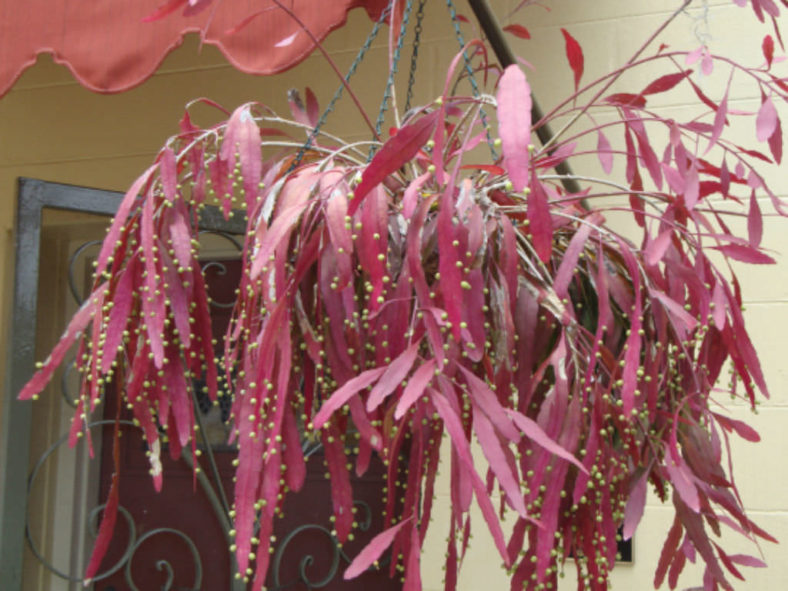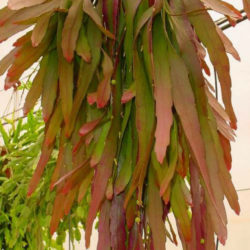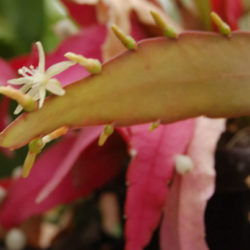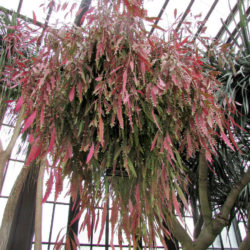Scientific Name
Pseudorhipsalis ramulosa (Salm-Dyck) Barthlott
Common Name(s)
Red Mistletoe Cactus, Red Rhipsalis
Synonym(s)
Cactus ciliare, Cereus ramulosus, Disocactus ramulosus, Epiphyllum ciliare, Hariota ramulosa, Kimnachia ramulosa, Pseudorhipsalis ramulosa subsp. ramulosa, Rhipsalis ramulosa
Scientific Classification
Family: Cactaceae
Subfamily: Cactoideae
Tribe: Hylocereeae
Genus: Pseudorhipsalis
Description
Pseudorhipsalis ramulosa, also known as Rhipsalis ramulosa or Kimnachia ramulosa, is a much-branched, spineless cactus with pendent, cylindrical, basally woody stems and flattened lateral branches with scalloped edges. It grows up to 3.3 feet (1 m) long. Branches are green with reddish tips, turning deep violet-red in intense sunlight. They are up to 10 inches (25 cm) long and 0.6 inches (1.5 cm) wide.
Flowers are greenish-white or pinkish, up to 0.5 inches (1.2 cm) long and up to 0.6 inches (1.5 cm) in diameter, and appear from the areoles in summer. The ornamental fruits are white to pinkish-white, ovoid berries up to 0.3 inches (0.8 cm) in diameter.
Origin
Pseudorhipsalis ramulosa has a wide distribution. It grows as an epiphyte in Mexico, Guatemala, Belize, Honduras, Nicaragua, Costa Rica, Colombia, Venezuela, Ecuador, Peru, Brazil, Bolivia, Haiti, and Jamaica.

Hardiness
USDA hardiness zone 10a to 11b: from 30 °F (−1.1 °C) to 50 °F (+10 °C).
How to Grow and Care
Rhipsalis do not thrive in direct sunlight. Exposure to the afternoon sun can burn the leaves, turn them yellow, or lead to spotting. However, without sufficient sunlight, They will not bloom, and their growth can be stunted. Therefore, Rhipsalis does best with the morning sun and full shade in the afternoon.
As Rhipsalis is commonly grown indoors, care must be given to the placement of the plants. They should be kept at least 20 inches (50 cm) from windows that receive midday or afternoon sun. The glass in the windows can multiply the heat from the sun's rays, causing sunburned leaves. Keep in mind that in its native environment, Rhipsalis is accustomed to receiving light filtered through dense, overhanging tree branches. Picturing this environment can help you adjust your lighting accordingly.
Rhipsalis is not a drought-resistant plant, so regular watering is essential. Over-watering, however, can cause weak stems and rotted roots. Using a watering can help you measure the amount of water you are providing. The size of the pot compared to the size of the plant, the humidity levels in the home, and the type of potting soil used can all affect the watering frequency.
See more at How to Grow and Care for Rhipsalis.
Links
- Back to genus Pseudorhipsalis
- Succupedia: Browse succulents by Scientific Name, Common Name, Genus, Family, USDA Hardiness Zone, Origin, or cacti by Genus
Photo Gallery
Click on a photo to see a larger version.


